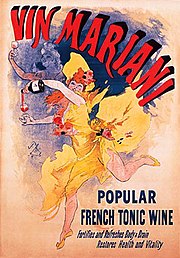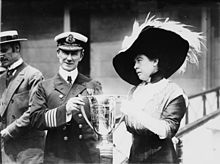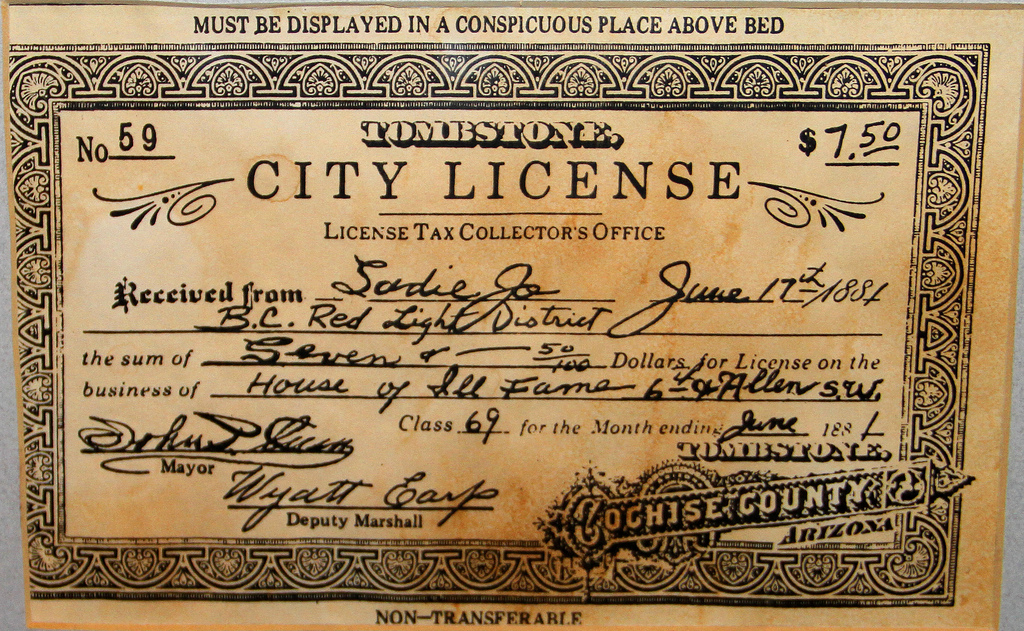
Hello. I'm writer Antoinette Beard/Sorelle Sucere. Welcome to my blog, which is dedicated to all the loving, intelligent, brave, wise, strong, gentle, kind, sweet-and-geeky, humble-and-patient, --- whether they have hands, paws, hooves, wings, fins, or even, --- yes, flippers, --- and to all eager readers and hard-working authors, everywhere.
Meanwhile...

I love all creatures. I consider them, all of them, to be sentient beings... I write thrillers, fantasy, mysteries, gothic horror, romantic adventure, occult, Noir, westerns and various types of short stories. I also re-tell traditional folk tales and make old fairy tales carefully cracked. I'm often awake very early in the morning. A cuppa, and fifteen minutes later I'm usually writing something. ;)
Tuesday, December 25, 2018
Friday, December 21, 2018
Thursday, December 20, 2018
Harry Potter & The Chamber Of Secrets, --- Harry's first time at the Weasly's House...
I loved that they kept their pigs on the roof.
Friday, December 14, 2018
Thursday, December 13, 2018
Harry Potter and the Order of the Phoenix - christmas scene (HD)
Heh-heh-heh... Sweet Molly Weasley's horrible scarves, --- included!!!... :D
Wednesday, December 12, 2018
Monday, December 10, 2018
Friday, November 30, 2018
The History Of... [Drum roll!!!]... BAGELS!!!... :D

A bagel salesman in Poland, 1935
Linguist Leo Rosten wrote in The Joys of Yiddish about the first known mention of the Polish word bajgiel derived from the Yiddish word bagel in the "Community Regulations" of the city of Kraków in 1610, which stated that the food was given as a gift to women in childbirth.
In the 16th and first half of the 17th centuries, the bajgiel became a staple of Polish cuisine[7] and a staple of the Slavic diet generally. Its name derives from the Yiddish word beygal from the German dialect word beugel, meaning "ring" or "bracelet".
Variants of the word beugal are used in Yiddish and in Austrian German to refer to a similar form of sweet-filled pastry (Mohnbeugel (with poppy seeds) and Nussbeugel (with ground nuts), or in southern German dialects (where beugerefers to a pile, e.g., holzbeuge "woodpile"). According to the Merriam-Webster dictionary, 'bagel' derives from the transliteration of the Yiddish 'beygl', which came from the Middle High German 'böugel' or ring, which itself came from 'bouc' (ring) in Old High German, similar to the Old English bēag "ring" and būgan "to bend, bow".[10] Similarly, another etymology in the Webster's New World College Dictionary says that the Middle High German form was derived from the Austrian German beugel, a kind of croissant, and was similar to the German bügel, a stirrup or ring.
In the Brick Lane district and surrounding area of London, England, bagels (locally spelled "beigels") have been sold since the middle of the 19th century. They were often displayed in the windows of bakeries on vertical wooden dowels, up to a metre in length, on racks.

Bagels with cream cheese and lox (cured salmon) are considered a traditional part of American Jewish cuisine (colloquially known as "lox and a schmear").
Bagels were brought to the United States by immigrant Polish Jews, with a thriving business developing in New York City that was controlled for decades by Bagel Bakers Local 338. They had contracts with nearly all bagel bakeries in and around the city for its workers, who prepared all their bagels by hand.
The bagel came into more general use throughout North America in the last quarter of the 20th century with automation. Daniel Thompson started work on the first commercially viable bagel machine in 1958; bagel baker Harry Lender, his son, Murray Lender, and Florence Sender leased this technology and pioneered automated production and distribution of frozen bagels in the 1960s. Murray also invented pre-slicing the bagel.
Around 1900, the "bagel brunch" became popular in New York City.[16] The bagel brunch consists of a bagel topped with lox, cream cheese, capers, tomato, and red onion. Th is and similar combinations of toppings have remained associated with bagels into the 21st century in the US.
In Japan, the first kosher bagels were brought by BagelK [ja] from New York in 1989. BagelK created green tea, chocolate, maple-nut, and banana-nut flavors for the market in Japan. There are three million bagels exported from the U.S. annually, and it has a 4%-of-duty classification of Japan in 2000. Some Japanese bagels, such as those sold by BAGEL & BAGEL [ja], are soft and sweet; others, such as Einstein Bro. bagels sold by Costco in Japan, are the same as in the U.S.
Sunday, November 18, 2018
Thursday, November 1, 2018
Sunday, October 21, 2018
Saturday, October 20, 2018
Sunday, September 30, 2018
A Town Shame, --- The Gem Theater & Saloon In Deadwood, South Dakota...

Swearengen opened the Gem Variety Theater on April 7, 1877, at the corners of Wall and Main streets, to entertain the population of the mining camp with "prize fights" (as was customary with Swearengen's previous establishment the Cricket Saloon, no prizes were actually involved), stage acts consisting of comedians, singers and dancers, and, primarily, prostitutes.
Gambling was a main theme at the Gem, as was the Gem band, who played nightly from the balcony as a form of advertising.
Management
Swearengen recruited his prostitutes by advertising legitimate stage, cleaning, or waitressing jobs in his theater to desperate young women and advancing them the money for their (one way) trip; then, when they arrived, forcing them into what was essentially indentured servitude as prostitutes. Those who balked were first threatened with demands for repayment of the funds advanced to them for the trip; if that failed, they were threatened with beatings, and if that failed they were beaten and physically forced to submit to Swearengen's demands. Many still resisted, but those who escaped this fate could only find themselves in no better situation, as penniless women with no source of income, alone in a rough and rowdy mining camp, and with the constant threat of Swearengen's men hanging over them. Many grew sick and died from lack of proper nutrition and shelter, while many others committed suicide.
The Gem prospered, bringing in an average of $5,000 a night, even reaching as high as $10,000. Swearengen forged alliances with many of Deadwood's most prominent citizens, buying himself immunity from legal or other problems. His immunity even extended to the notoriously upright and incorruptible Marshal Seth Bullock, who did not have the political clout to extend his campaign to clean up the town as far as the lower regions of Main Street, which remained Swearengen's territory.
The front of the Gem consisted of a bar, and the "theater" area; in the back were the rooms for the prostitutes. Day-to-day operations were managed by a staff including Dan Doherty and Johnny Burnes (both portrayed in Deadwood, although the real-life individuals were reputed to be much more brutal to the prostitutes than seen in the series, as was Swearengen himself). Customers frequently brutalized the women, even to the point of killing them.
The violence in the Gem was not confined to the prostitutes, with the saloon being a frequent site of gunfights between drunken patrons; and in one memorable instance, the memoirs of John S. McClintock reported a prostitute named "Trixie" having shot a large hole through the skull of a man who astounded everyone by surviving for another half an hour.
Destruction
The Gem was damaged by fire in the summer of 1879 and repaired, but then very soon destroyed in a major fire that devastated the town on September 26, 1879. Swearengen built an even larger and more grand establishment, reopening in December 1879 to adulation as the finest theater ever seen in Deadwood.
In 1899, however, the Gem burned down once again, and a penniless Swearengen declined to rebuild and left for Colorado. Despite the Gem's history as Deadwood's longest-lived entertainment institution, its support by so many of the town power brokers over the years, and the glowing tributes in the press after the rebuilt Gem was unveiled, after its demise it was reviled in the press as an evil institution and a town shame.
Monday, September 24, 2018
Sunday, September 23, 2018
Saturday, September 22, 2018
Michael Greyeyes, Native American Actor...
He is of the Cree Nation, and is also a choreographer and has been to pow wows, dancing beautifully. To me, he looks like some of the heroes in my novels of the Wild West.
Friday, September 21, 2018
Thursday, September 20, 2018
Wednesday, September 19, 2018
Mariani Wine In The Old West...
Vin Mariani (French: Mariani wine) was a tonic and patent medicine created about 1863 by Angelo Mariani, a French chemist from the island of Corsica who became intrigued with coca and its economic potential after reading Paolo Mantegazza’s paper on coca's effects. In 1863. Mariani started marketing a coca wine called Vin Tonique Mariani (à la Coca du Pérou)[1] which was made from Bordeaux wine and coca leaves.
The ethanol in the wine acted as a solvent and extracted the cocaine from the coca leaves, altering the drink’s effect. It originally contained 6 mg of cocaine per fluid ounce of wine (211.2 mg/L), but Vin Mariani that was to be exported contained 7.2 mg per ounce (253.4 mg/L), in order to compete with the higher cocaine content of similar drinks in the United States. Advertisements for Vin Mariani claimed that it would restore health, strength, energy and vitality.
Promotion and testimonials
Mariani marketed the Vin Mariani for a number of ailments, touting its ability to increase energy, appetite and mood. It was promoted as a performance enhancer for creatives and athletes alike, and was endorsed by many notable people of its time. Mariani solicited testimonials from a broad range of European celebrities, including members of various royal families, politicians, artists, writers and other household names, and reprinted them in newspapers and magazines as advertisements. He claimed to have collected over four thousand such endorsements.
Pope Leo XIII and later Pope Saint Pius X were both Vin Mariani drinkers. Pope Leo appeared on a poster endorsing the wine and awarded a Vatican gold medal to Mariani for creating it. Thomas Edison claimed it helped him stay awake longer. Ulysses S. Grant drank Vin Mariani while writing his memoirs towards the end of his life. Jules Méline, the French prime minister, drank the wine despite being otherwise anti-alcohol.
Other notables who endorsed Vin Mariani include Émile Zola, Victorien Sardou, Henri Rochefort and Charles Gounod, all of whom wrote testimonials that appeared as Vin Mariani advertisements.
Inspiration for Coca-Cola
This tonic evidently inspired John S. Pemberton's 1885 coca wine drink, Pemberton's French Wine Coca. Pemberton's recipe was very similar to that of Vin Mariani, including the coca leaves. It was differentiated only by the inclusion of the African kola nut, the beverage's source of caffeine. Later that year, when Atlanta and Fulton County, Georgia, passed prohibition legislation, Pemberton responded by developing a carbonated, non-alcoholic version of his French Wine Coca. He called the reformulated beverage Coca-Cola, for its stimulant ingredients coca leaves and kola nuts.
Tuesday, September 18, 2018
Where Did The Term "Bluestocking" Come From???... ;)

Caricature of blue stockings by Rowlandson
A bluestocking is an educated, intellectual woman, originally a member of the 18th-century Blue Stockings Society led by the hostess and critic Elizabeth Montagu (1720–1800), the "Queen of the Blues", including Elizabeth Vesey (1715–91), Hester Chapone (1727–1801) and the classicist Elizabeth Carter (1717–1806). In the following generation came Hester Lynch Piozzi (1741–1821), Hannah More (1745–1833) and Frances Burney (1752–1840).
Until the late 18th century, the term had referred to learned people of both sexes. It was later applied primarily to intellectual women and the French equivalent bas bleu had a similar connotation.[3] The term later developed negative implications and in some instances such women were stereotyped as being "frumpy". The reference to blue stockings may arise from the time when woollen worsted stockings were informal dress, in contrast to formal, fashionable black silk stockings. The most frequent such reference is to a man, Benjamin Stillingfleet, who reportedly lacked the formal black stockings, yet participated in the Blue Stockings Society.
Champion Of Human Rights: The Unconventional, & "Unsinkable" Margaret [Molly] Brown... :D

Margaret "Maggie" Brown (née Tobin; July 18, 1867 – October 26, 1932), posthumously known as "The Unsinkable Molly Brown", was an American socialite and philanthropist. She is best remembered for encouraging the crew in Lifeboat No. 6 to return to the debris field of the 1912 sinking of RMS Titanic to look for survivors. Accounts differ on whether the boat actually returned to look for survivors, and if so, whether any survivors were found. During her lifetime, her friends called her "Maggie", but even by her death, obituaries referred to her as the "Unsinkable Mrs. Brown". The reference was further reinforced by a 1960 Broadway musical based on her life and its 1964 film adaptation which were both entitled The Unsinkable Molly Brown.Margaret Tobin was born in a two-room cottage, near the Mississippi River in Hannibal, Missouri, on what is now known as Denkler's alley. Her parents were Irish Catholic immigrants John Tobin (1823–1899) and Johanna (Collins) Tobin (1825–1905). Her siblings were Daniel Tobin (born 1863), Michael Tobin (born 1866), William Tobin (born 1869), and Helen Tobin (born 1871). Both of Margaret's parents had been widowed young. Brown also had two half-sisters: Catherine Bridget Tobin (born 1856), by her father's first marriage, and Mary Ann Collins (born 1857), by her mother's first marriage.
At age 18, Margaret relocated to Leadville, Colorado, with her siblings Daniel Tobin, Mary Ann Collins Landrigan, and Mary Ann's husband John Landrigan. Margaret and her brother Daniel shared a two-room log cabin, and she found a job in a department store.
Marriage and children
In Leadville, she met and married James Joseph Brown (1854–1922), nicknamed "J.J.", an enterprising, self-educated man. He wasn't a rich man, but she married J.J. for love. She said,
I wanted a rich man, but I loved Jim Brown. I thought about how I wanted comfort for my father and how I had determined to stay single until a man presented himself who could give to the tired old man the things I longed for him. Jim was as poor as we were, and had no better chance in life. I struggled hard with myself in those days. I loved Jim, but he was poor. Finally, I decided that I'd be better off with a poor man whom I loved than with a wealthy one whose money had attracted me. So I married Jim Brown.
Margaret and J.J. were married in Leadville's Annunciation Church on September 1, 1886.[3] They had two children: Lawrence Palmer Brown (1887–1949), known as Larry and Catherine Ellen Brown (1889–1969), known as Helen.
Mining success
The Brown family acquired great wealth when in 1893 J.J.'s mining engineering efforts proved instrumental in the production of a substantial ore seam at the Little Jonny Mine of his employers, Ibex Mining Company, and he was awarded 12,500 shares of stock and a seat on the board. In Leadville, Margaret helped by working in soup kitchens to assist miners' families.
In 1894, the Browns bought a $30,000 Victorian mansion in Denver, Colorado, and in 1897, they built a summer house, Avoca Lodge in Southwest Denver near Bear Creek, which gave the family more social opportunities. Margaret became a charter member of the Denver Woman's Club, whose mission was the improvement of women's lives by continuing education and philanthropy. Adjusting to the trappings of a society lady, Brown became well-immersed in the arts and fluent in French, German, Italian, and Russian. Brown co-founded a branch in Denver of the Alliance Française to promote her love of French culture. Brown gave parties that were attended by Denver socialites, but she was unable to gain entry into the most elite group, Sacred 36, who attended exclusive bridge parties and dinners held by Louise Sneed Hill. Brown called her "the snobbiest woman in Denver".
After 23 years of marriage, Margaret and J.J. privately signed a separation agreement in 1909. Although they never reconciled, they continued to communicate and cared for each other throughout their lives. The agreement gave Margaret a cash settlement, and she maintained possession of the house on Pennsylvania Street in Denver and the summer house, Avoca Lodge. She also received a $700 monthly allowance (equivalent to $19,066 today) to continue her travels and social work.
Brown assisted in fundraising for Denver's Cathedral of the Immaculate Conception, which was completed in 1911. She also worked with Judge Ben Lindsey to help destitute children and establish the United States' first juvenile court, which helped form the basis of the modern U.S. juvenile courts system.
Brown giving Captain Arthur Henry Rostron an award for his service in the rescue of survivors of the Titanic.
Brown had spent the first months of 1912 traveling in Egypt as part of the John Jacob Astor IV party, until she received word from Denver that her eldest grandchild Lawrence Palmer Brown Jr. was seriously ill. She immediately booked passage on the first available liner leaving for New York, the RMS Titanic. Originally her daughter Helen was supposed to accompany her, but she decided to stay on in Paris, where she was studying at the Sorbonne. Brown was conveyed to the passenger liner RMS Titanic as a first class passenger on the evening of April 10, aboard the tender SS Nomadic at Cherbourg, France.
The Titanic sank early on April 15, 1912, at around 2:20 a.m., after striking an iceberg at around 11:40 p.m. Brown helped others board the lifeboats but was finally persuaded to leave the ship in Lifeboat No. 6.[1] Brown was later called "The Unsinkable Molly Brown" by authors because she helped in the ship's evacuation, taking an oar herself in her lifeboat and urging that the lifeboat go back and save more people. Her urgings were met with opposition from Quartermaster Robert Hichens, the crewman in charge of Lifeboat 6. Hichens was fearful that if they went back, the lifeboat would either be pulled down due to suction or the people in the water would swamp the boat in an effort to get inside. After several attempts to urge Hichens to turn back, Brown threatened to throw the crewman overboard.[1] Sources vary as to whether the boat went back and if they found anyone alive. Brown's efforts sealed her place in history, regardless.
Upon being rescued by the ship RMS Carpathia, Brown proceeded to organize a survivors' committee with other first-class survivors. The committee worked to secure basic necessities for the second and third class survivors and even provided informal counseling.
Later life and death
Brown ran for Senate in 1914 but ended her campaign to return to France to work with the American Committee for Devastated France during World War I.
At the time of J.J. Brown's death on September 5, 1922, Margaret told newspapers, "I've never met a finer, bigger, more worthwhile man than J.J. Brown." J.J. died intestate, and five years of disputation between Margaret and her two children were required to finally settle the estate. Due to their lavish spending, J.J. left an estate valued at only $238,000, equal to $3,479,626 today. Maggie was to receive $20,000 in cash and securities (equal to $292,406 today), and the interest on a $100,000 trust fund (equal to $1,462,028 today) in her name. $118,000 was to be divided between her two children, who each received a $59,000 (equal to $862,596 today) trust fund. A court case against Catherine and Lawrence was settled privately, and Margaret and her children were reconciled at the time of Margaret's death in 1932.
During the last years of her life, she was an actress. Margaret Brown died in her sleep at 10:55 p.m. on October 26, 1932, at the Barbizon Hotel in New York City, New York. Subsequent autopsy revealed a brain tumor. Her body was buried along with J.J. in the Cemetery of the Holy Rood in Westbury, New York, following a small ceremony on October 31, 1932, attended only by family members. There was no eulogy.
Legacy
Margaret's fame as a well-known Titanic survivor helped her promote the issues she felt strongly about: the rights of workers and women, education and literacy for children, historic preservation, and commemoration of the bravery and chivalry displayed by the men aboard the Titanic. During World War I in France, she worked with the American Committee for Devastated France to rebuild areas behind the front line, and helped wounded French and American soldiers. She was awarded the French Légion d'Honneur for her good citizenship, activism, and philanthropy in America.
Monday, September 17, 2018
"She Lied About Everything Except Marrying Wyatt Earp," --- From Messy Nessy...
A vagabond and speculated prostitute of the Wild West, nothing Josephine Earp ever did was seemingly adventurous enough even for herself. She thrived off the change of environments and had a certain mystique about her that followed her around like too much perfume. But that’s what drew people to her. That was Josie Earp’s style.
Born in New York City in 1860, the life of Josephine Sarah Marcuse (Josie, as she preferred to be known) has been pieced together through fact and fiction; a more romantic version of events fabricated by the woman herself vs the official documents that tell a different tale. By the age of thirteen, Josie was already crafting a life that didn’t actually belong to her. At first the fabrications were harmless, claiming her German father ran a successful mercantile business when in fact, he was a modest Prussian baker. According to Josie, she lived in a prosperous, comfortable Jewish community when she actually lived in a crowded and diverse neighbourhood where factory smoke fogged the air. But soon, her lies started to consume her, as she began inventing a glamorous life she could only ever have dreamed about.
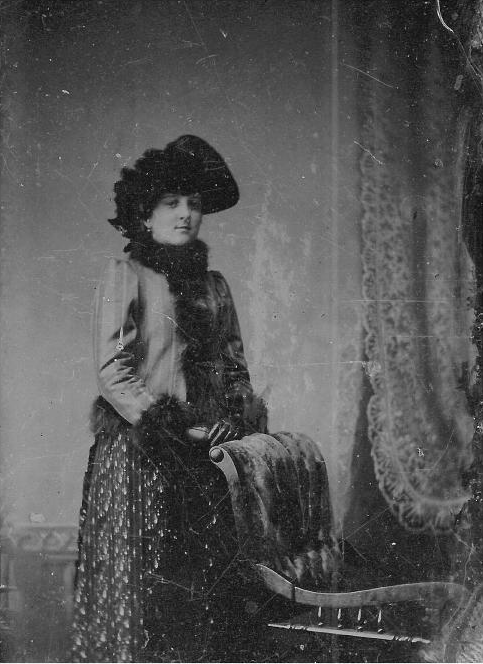
THIS PHOTO WAS TAKEN IN PRESCOTT, ARIZONA TERRITORY, IN 1880, AND IS BELIEVED TO BE OF A YOUNG JOSEPHINE
The girl who left home at the age of 14 once said, “There was far too much excitement in the air to remain a child.” She wrote in what is claimed to be her own memoirs years later that she recalled kissing her mother goodbye on the cheek, as if she was going to school, and never returning home.
Josie prided herself on having been a part of the Pauline Markham Pinafore Dance Troupe. Her memoir even gives her recollection of sailing down the Californian coast with the Troupe and her friend Dora (who never existed), making a pit stop in Santa Barbara before boarding a stagecoach to Arizona.
In reality, the Markham Troupe left for Arizona via train in October of 1879, not by ship. Her name was never seen on a program or document of any sort from the Troupe. Whatever she was trying to hide, Josie wasn’t very good at covering her tracks.
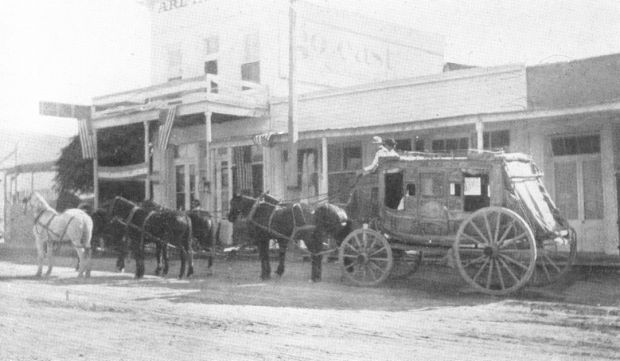
STAGECOACH TRAVEL IN 1880S ARIZONA TERRITORY
Either way, Josie she and “Dora” supposedly hopped on a stagecoach and headed straight for Arizona after spending the night in Santa Barbara. However, when talk arose of “Apache Indians escaping from their reservations,” Josie and Dora were whisked away to a ranch house for safety by Al Sieber, a famous Indian scout. They would spend 10 days there, sleeping on the floor and making new “acquaintances”. In the midst of it all, Josie met her future love interest – the handsome Johnny Behan.
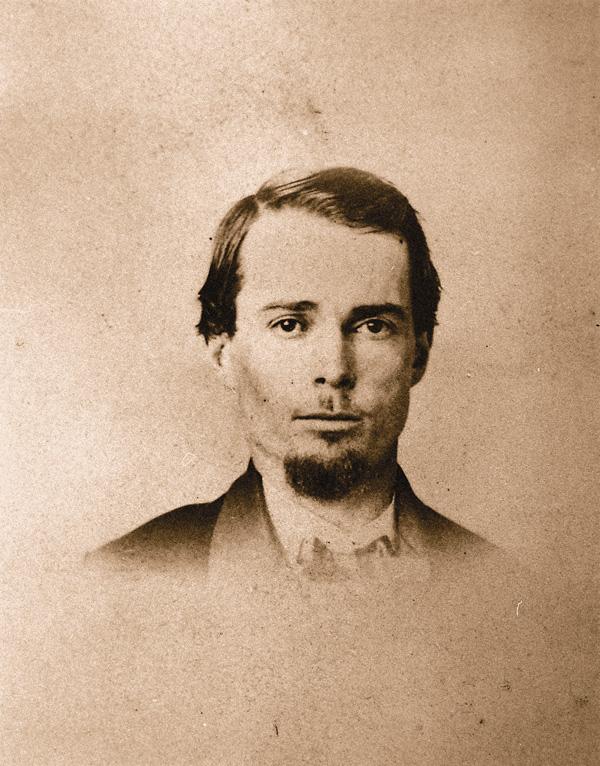
JOHNNY BEHAN
After her extended stay in Santa Barbara, Josie claims she and Dora headed back to San Francisco. But did she really ever return home? It seems as though Behan was too much of a catch to leave behind in Arizona. Records show that during that December of 1874, Behan was a frequent customer of “the house of ill fame” visiting the same 14-year-old prostitute, Sadie Mansfield who coincidentally shares many life parallels with Josie Earp.
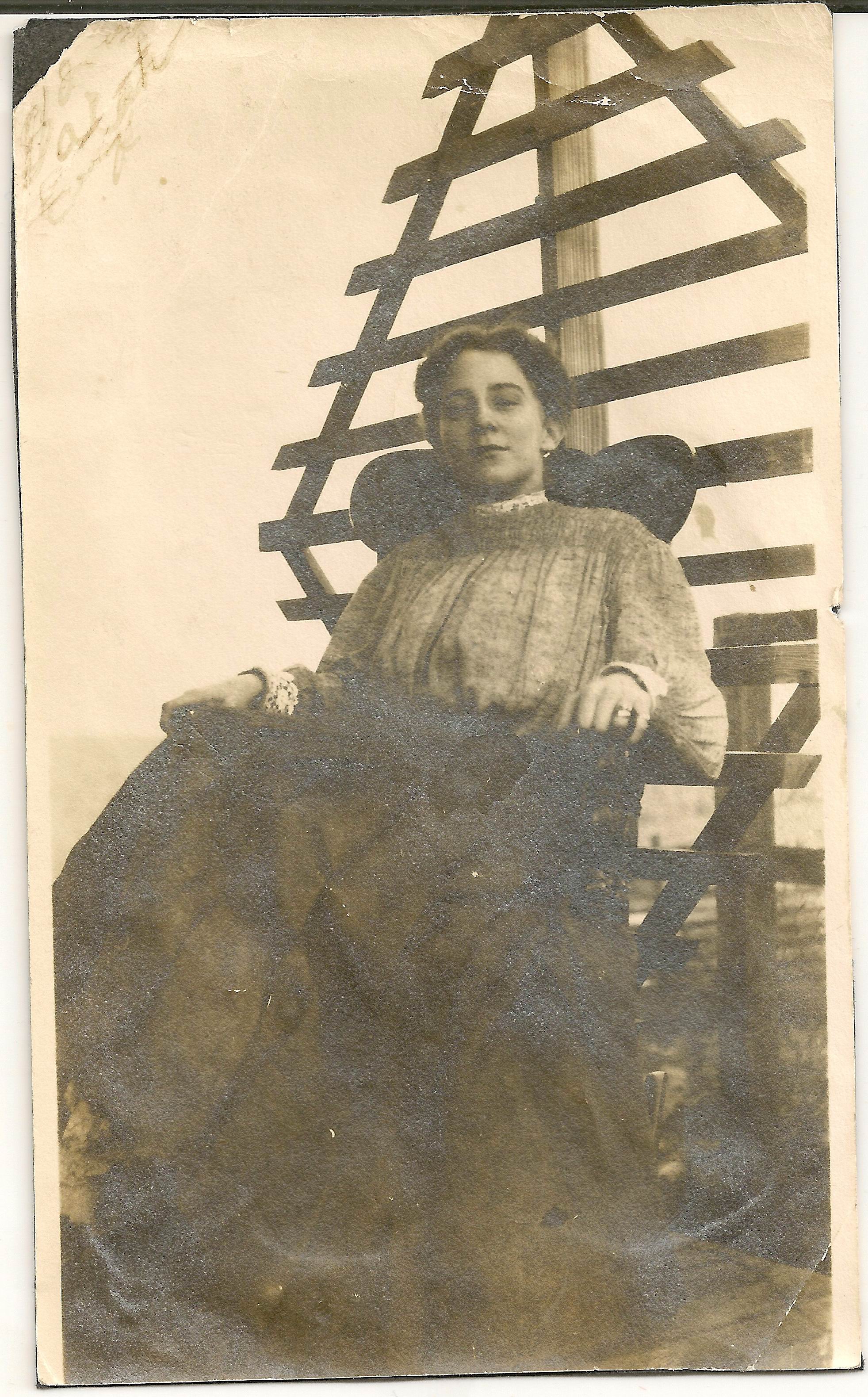
JOSEPHINE EARP OR SADIE MANSFIELD?
There is no solid proof that Sadie Mansfield is in fact Josie Earp, however, the years between 1874-1882 are a chunk of Earp’s life that are non-existent according to records. When asked about this time in her life, she recounts in her memoir that it was one big “bad dream.” It is widely speculated that Sadie Mansfield was in fact the alias of Josephine Sarah Marcuse. “Sadie” was a well-known nickname for Sarah, and it was common for prostitutes to change their first name. Sadie Mansfield and Sadie Marcuse both made a stagecoach journey from San Francisco to Arizona Territory, both became sexual partners of Johnny Behan, both 19 years old, born in New York City, and had parents from Prussia. It seems pretty safe to say that Josie’s lost years were spent at working at a brothel in Arizona under the name of Sadie Mansfield.
In 1880, records show that a Miss Sadie Mansfield was working for Johnny Behan at the Grand Hotel in Tombstone, Arizona, when she allegedly caught the eye of a man named Wyatt Earp, a name as legendary at Tombstone itself.
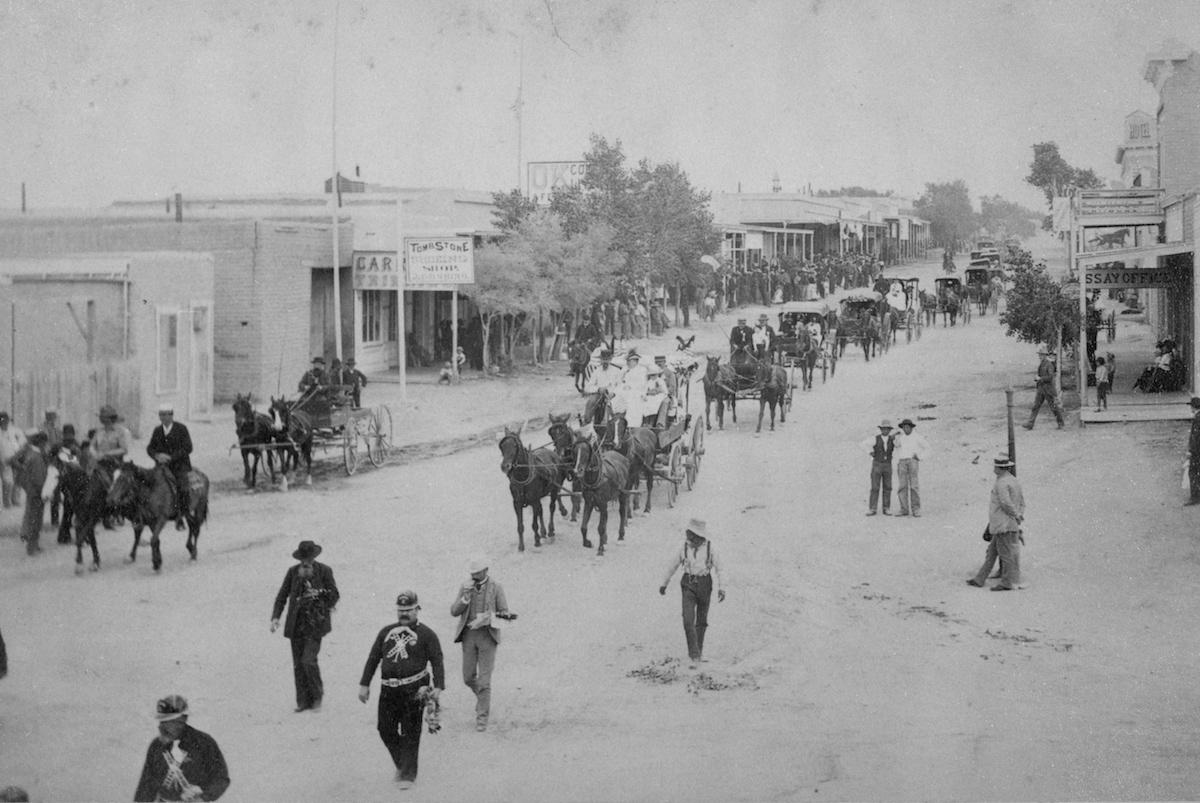
TOMBSTONE, ARIZONAAccording to those close to Earp, he pursued the young courtesan, despite his own common law marriage to another and her relationship with Johnny Behan, his political and personal antagonist. By the summer of 1882, Sadie was married to Wyatt Earp, the famous gambler and deputy sheriff, who would lead the most famous shootout in the history of the American Wild West. The ceremony allegedly took place on a yacht off the California coast but no public record of their marriage has ever been found.
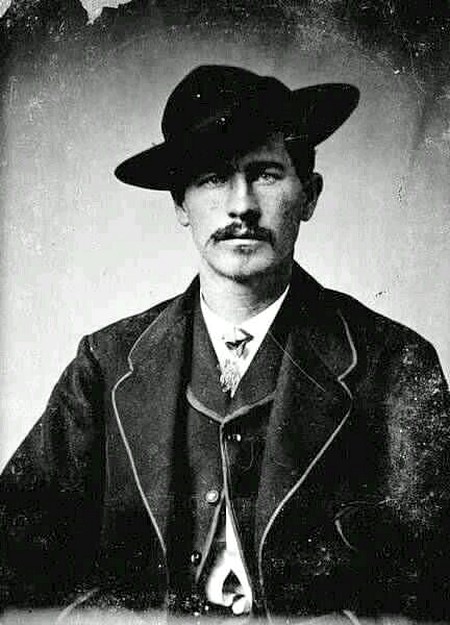
WYATT EARP
After the legendary gunfight in Tombstone that lasted only 30 seconds, but would up defining Earp for the rest of his life, Earp and his new common law wife Sadie (a.k.a Josie) traveled around the west, scoring money in the gold rush and by investing in properties. Sadie apparently gambled their money recklessly and had to be cut off from their finances. Their marriage was quite rocky according to friends and family. After a stint in Alaska during the mining boom, the Earp’s returned with nearly $80,000 ($2.3 million today), which they lived off for most of their lives. However, during the last years of her husband’s life, she gambled away the last of their money, leaving them both destitute.
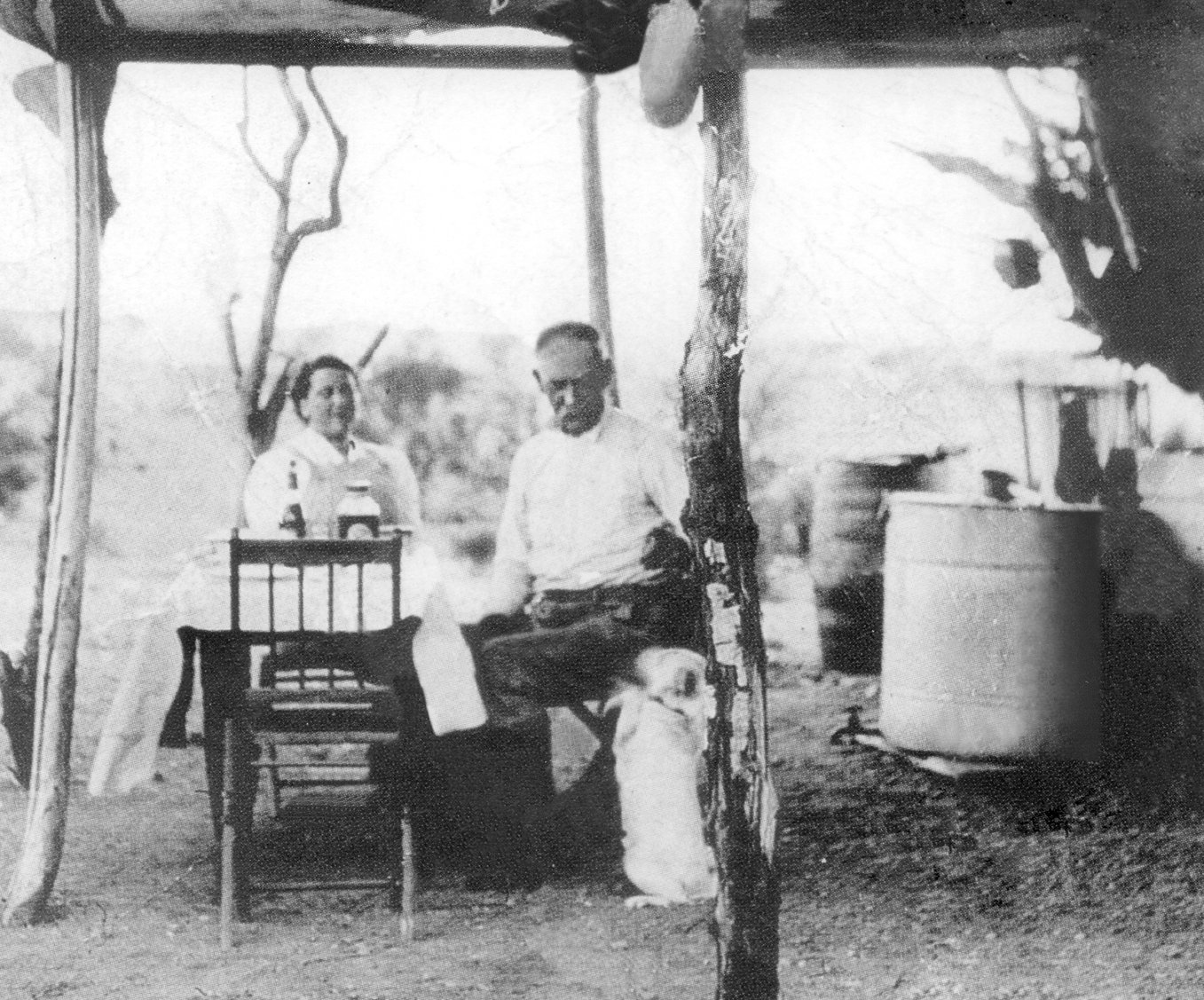
IN A RARE PHOTO OF THE COUPLE TOGETHER, JOSIE MARCUS SITS WITH WYATT EARP IN THEIR DESERT CAMP AT THEIR HAPPY DAYS GOLD MINE, ACROSS THE RIVER FROM PARKER, ARIZONA, IN THE 1920S © JEFF MOREY
When Wyatt died, Sadie didn’t attend the funeral or help with it – she claimed she was too shocked and devastated. “She didn’t go to his funeral. She wasn’t that upset. She was peculiar,” said Grace Spolidora, a family friend who spent a lot of time with the Earp’s. “I don’t think she was that devastated when he died.” After Wyatt’s death, she stopped going by “Sadie” and told everyone to call her Josie. She hated the name Sadie.
Three years after his death, a best-selling book about Earp was published by Stuart Lake in 1931. Stuart Lake once said “Johnny Behan’s girl” (Sadie) was “the key to the whole yarn of Tombstone”. In an effort to control and sanitize her husband’s story and more importantly, to keep her own murky past a secret, Sadie threatened litigation against anyone who tried to tell their story. She succeeded in refuting claims that the great Wyatt Earp was ever a drinker, gambler, saloon-keeper and even a brothel-keeper. Strong evidence suggests however, that the Earps had quite the colourful resumé.
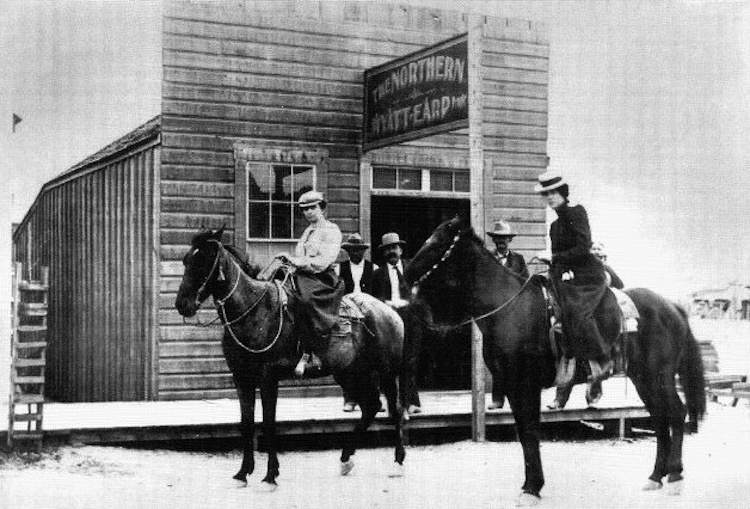
WYATT’S SALOON IN TONOPAH, NEVADAH IN 1902. IT’S VERY LIKELY THAT HIS WIFE, JOSIE, IS ON THE HORSE ON THE LEFT.
Finding an authenticated photograph of the elusive Josephine Earp is also quite a challenge. The photographs you’ve been looking at in this article have all purported to be of Josephine at one time or another, but the true provenance for many of them remains unconfirmed.
Josephine’s cousins had attempted to document her life after Wyatt’s death, recording events in her later life, but found Josephine to be extremely evasive and imprecise when talking about her early life in Tombstone and the Arizona Territory. They finally abandoned their efforts and the manuscript was left unfinished.
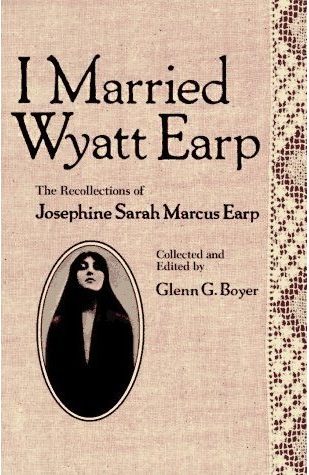
GLEN BOYER’S CONTROVERSIAL 1976 BOOK, “I MARRIED WYATT EARP”.
In 1974, an American writer and Wild West enthusiast Glenn Boyer published I Married Wyatt Earp, a memoir based on various manuscripts, hand-written notes and material supposedly written by Josephine and close friends during her lifetime.
The memoir became the second-best selling book about Wyatt Earp, selling over 35,000 copies. It was frequently referenced by scholars and filmmakers. Prior to writing the book, Glenn had been contacted by Wyatt’s relations who had known “Aunt Josie” in the 1930s, and accumulated 32 boxes of family pictures, correspondence, hand-written notes, audio recordings, memorabilia, along with manuscripts that he used as source material for several books.
As ever, in the search for the truth about Josephine, her story was once again brought into question in 1994, when critics began discrediting Glenn Boyer’s work as largely fictional. Just like Josephine, he was accused of inventing large parts of her life, even inventing sources entirely. The University of Arizona, Boyer’s embarrassed publisher, was forced to remove the book from their catalogue. In an interview, Boyer later said, “I have never promoted myself as a historian. So I put words in Josephine’s mouth. So what? Stuart Lake did it. I admit to making it interesting enough to be read, which it appears to be alleged is unethical”.
It almost seems as if the web of lies Josephine Earp left behind will forever prevent us from knowing her truth. Just as she intended.
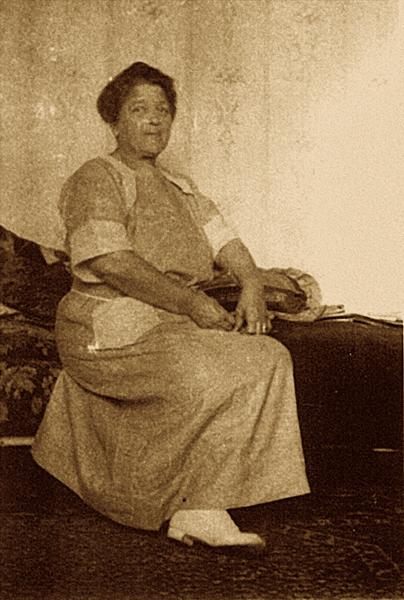
AUTHENTICATED PHOTOGRAPH OF JOSEPHINE EARP
Master of deception, Josephine Sarah Marcus Earp died in Los Angeles on December 20, 1944, without a penny to her name, she was buried with her truth.
Subscribe to:
Posts (Atom)

